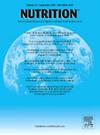High prevalence of suboptimal nutrient intake and comorbidities of people living with HIV on antiretroviral therapy
IF 3.2
3区 医学
Q2 NUTRITION & DIETETICS
引用次数: 0
Abstract
Objectives
Nutritional alterations are common in people living with human immunodeficiency virus (PLWH). Suboptimal intake of key nutrients contributes to the development of comorbidities, disease progression, and mortality. We sought to determine the prevalence of suboptimal nutritional intake and evaluate associations with metabolic alterations and immune activation in PLWH on long-term antiretroviral treatment (ART).
Methods
This is a cross-sectional study composed of 72 PLWH on ART. Daily intake of macronutrients and micronutrients was calculated. Cholesterol, triglycerides and glucose levels were determined. Body composition and bone mineral density were assessed using dual-energy x-ray absorptiometry. T-cell immune activation (CD38+HLADR+) and inflammatory cytokines (interleukins 1 and 6 and tumor necrosis factor-α) were measured. Statistical analyses were conducted using STATA v18.
Results
Suboptimal intakes of fluoride (95.8%), iodine (90.2%), omega-6 (88.9%), potassium (86.1%), omega-3 (81.9%), vitamin E (79.1%), vitamin A (75%), magnesium (66.6%), manganese (58.3%), and molybdenum (50%) were observed. Obesity was observed in 52% of the studied population, and 51% had a low bone mineral density, 40% had hypertriglyceridemia, 14% had dyslipidemia, and 9% had hyperglycemia. A low intake of chromium was associated with a higher percentage of activated CD4+ T cells (P = 0.04), and a low intake of vitamin B3 was associated with a higher percentage of activated CD8+ T cells (P = 0.028). Moreover, a low intake of phosphorus and vitamin B3 was associated with increased levels of interleukins 1 and 6 and tumor necrosis factor-α in plasma (P < 0.05).
Conclusions
Our cohort of PLWH on ART has a high prevalence of suboptimal intake of diverse micronutrients and comorbidities. We saw no association between suboptimal intake and comorbidities. Studies focused on the particular nutritional requirements of PLWH are needed in order to design nutritional interventions to prevent deficiency states, delay the development of non–AIDS-associated comorbidities, and increase quality of life.
接受抗逆转录病毒治疗的艾滋病毒感染者营养摄入不足和合并症的高发率
目的:营养改变在人类免疫缺陷病毒(PLWH)感染者中很常见。关键营养素的次优摄入会导致合并症、疾病进展和死亡率的发生。我们试图确定营养摄入不佳的患病率,并评估长期抗逆转录病毒治疗(ART)与PLWH代谢改变和免疫激活的关系。方法对72例接受抗逆转录病毒治疗的患者进行横断面研究。计算每日宏量营养素和微量营养素的摄入量。测定胆固醇、甘油三酯和葡萄糖水平。采用双能x线吸收仪评估体成分和骨密度。检测t细胞免疫活化(CD38+HLADR+)和炎症因子(白细胞介素1、6和肿瘤坏死因子-α)。使用STATA v18进行统计分析。结果氟(95.8%)、碘(90.2%)、欧米茄-6(88.9%)、钾(86.1%)、欧米茄-3(81.9%)、维生素E(79.1%)、维生素A(75%)、镁(66.6%)、锰(58.3%)、钼(50%)的摄入量均为次优。研究人群中有52%的人肥胖,51%的人骨密度低,40%的人患有高甘油三酯血症,14%的人患有血脂异常,9%的人患有高血糖。低铬摄入量与较高的活化CD4+ T细胞百分比相关(P = 0.04),低维生素B3摄入量与较高的活化CD8+ T细胞百分比相关(P = 0.028)。此外,低磷和维生素B3摄入量与血浆中白细胞介素1、6和肿瘤坏死因子-α水平升高有关(P <;0.05)。结论接受抗逆转录病毒治疗的PLWH队列存在多种微量营养素摄入不达标及合并症的高发生率。我们没有发现次优摄入量和合并症之间的联系。为了设计营养干预措施,预防缺乏状态,延缓非艾滋病相关合并症的发展,提高生活质量,需要对PLWH的特定营养需求进行研究。
本文章由计算机程序翻译,如有差异,请以英文原文为准。
求助全文
约1分钟内获得全文
求助全文
来源期刊

Nutrition
医学-营养学
CiteScore
7.80
自引率
2.30%
发文量
300
审稿时长
60 days
期刊介绍:
Nutrition has an open access mirror journal Nutrition: X, sharing the same aims and scope, editorial team, submission system and rigorous peer review.
Founded by Michael M. Meguid in the early 1980''s, Nutrition presents advances in nutrition research and science, informs its readers on new and advancing technologies and data in clinical nutrition practice, encourages the application of outcomes research and meta-analyses to problems in patient-related nutrition; and seeks to help clarify and set the research, policy and practice agenda for nutrition science to enhance human well-being in the years ahead.
 求助内容:
求助内容: 应助结果提醒方式:
应助结果提醒方式:


